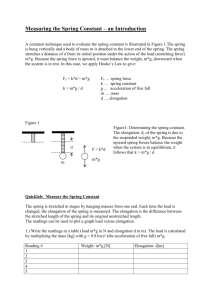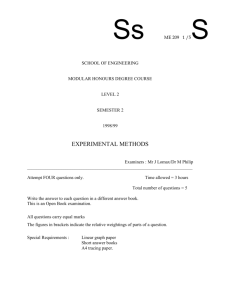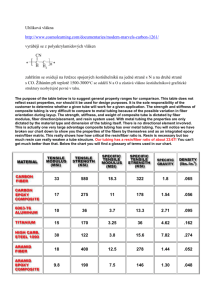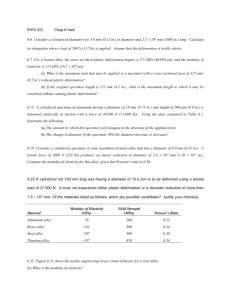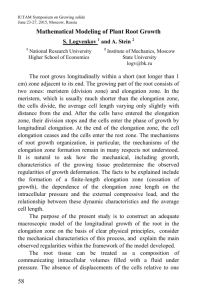pubdoc_3_14238_1261
advertisement
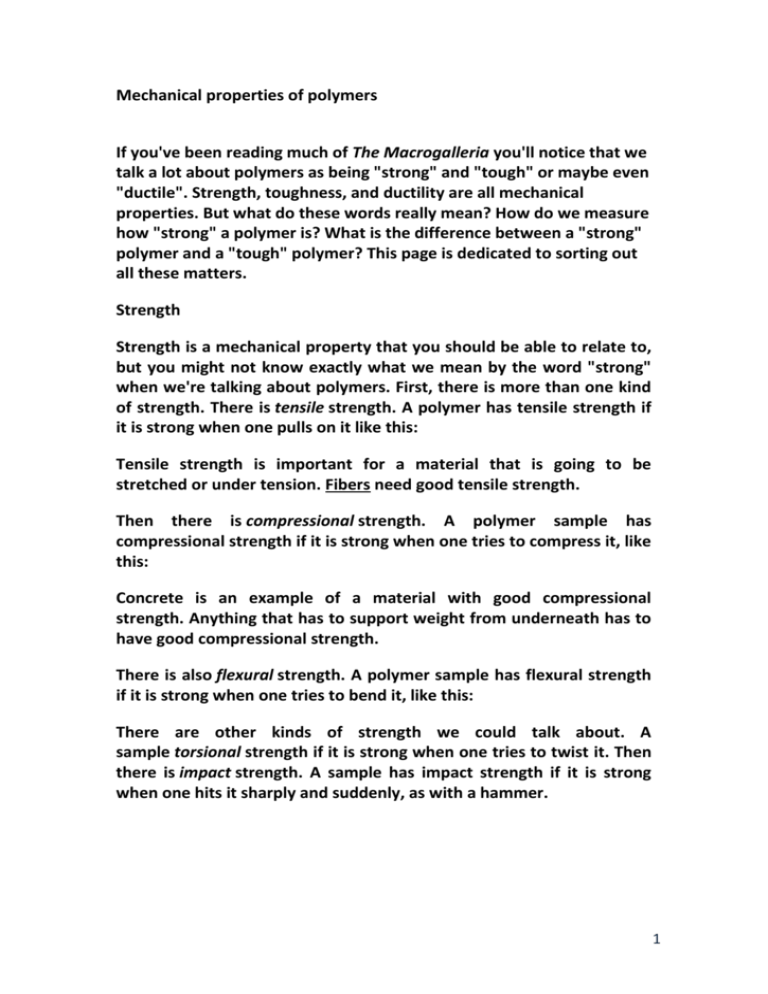
Mechanical properties of polymers If you've been reading much of The Macrogalleria you'll notice that we talk a lot about polymers as being "strong" and "tough" or maybe even "ductile". Strength, toughness, and ductility are all mechanical properties. But what do these words really mean? How do we measure how "strong" a polymer is? What is the difference between a "strong" polymer and a "tough" polymer? This page is dedicated to sorting out all these matters. Strength Strength is a mechanical property that you should be able to relate to, but you might not know exactly what we mean by the word "strong" when we're talking about polymers. First, there is more than one kind of strength. There is tensile strength. A polymer has tensile strength if it is strong when one pulls on it like this: Tensile strength is important for a material that is going to be stretched or under tension. Fibers need good tensile strength. Then there is compressional strength. A polymer sample has compressional strength if it is strong when one tries to compress it, like this: Concrete is an example of a material with good compressional strength. Anything that has to support weight from underneath has to have good compressional strength. There is also flexural strength. A polymer sample has flexural strength if it is strong when one tries to bend it, like this: There are other kinds of strength we could talk about. A sample torsional strength if it is strong when one tries to twist it. Then there is impact strength. A sample has impact strength if it is strong when one hits it sharply and suddenly, as with a hammer. 1 What is Strength? But what does it mean to be strong? We have a very precise definition. Let's use tensile strength to illustrate. To measure the tensile strength of a polymer sample, we take the sample and we try to stretch it just like in the picture above. We usually stretch it with a machine such as an Instron. This machine simply clamps each end of the sample, then, when you turn it on it stretches the sample. While it is stretching the sample, it measures the amount of force (F) that it is exerting. When we know the force being exerted on the sample, we then divide that number by the cross-sectional area (A) of our sample. The answer is the stress that our sample is experiencing. Then, using our machine, we continue to increase the amount of force, and stress naturally, on the sample until it breaks. The stress needed to break the sample is the tensile strength of the material. Likewise, one can imagine similar tests for compressional or flexural strength. In all cases, the strength is the stress needed to break the sample. Since tensile stress is the force placed on the sample divided by the cross-sectional area of the sample, tensile stress, and tensile strength as well, are both measured in units of force divided by units of area, usually N/cm2. Stress and strength can also be measured in megapascals (MPa) or gigapascals (GPa). It's easy to convert between the different units, because 1 MPa = 100 N/cm2, 1 GPa = 100,000 N/cm2, and of course 1 GPa = 1,000 MPa. Other times, stress and strength are measured in the old English units of pounds per square inch, or psi. If you ever have to convert psi to N/cm2, the conversion factor is 1 N/cm2 = 1.45 psi. Elongation But there's more to understanding a polymer's mechanical properties than merely knowing how strong it is. All strength tells us is how much stress is needed to break something. It doesn't tell us anything about what happens to our sample while we're trying to break it. That's where it pays to study the elongation behavior of a polymer sample. 2 Elongation is a type of deformation. Deformation is simply a change in shape that anything undergoes under stress. When we're talking about tensile stress, the sample deforms by stretching, becoming longer. We call this elongation, of course. Usually we talk about percent elongation, which is just the length the polymer sample is after it is stretched (L), divided by the original length of the sample (L0), and then multiplied by 100. There are a number of things we measure related to elongation. Which is most important depends on the type of material one is studying. Two important things we measure are ultimate elongation and elastic elongation Ultimate elongation is important for any kind of material. It is nothing more than the amount you can stretch the sample before it breaks. Elastic elongation is the percent elongation you can reach without permanently deforming your sample. That is, how much can you stretch it, and still have the sample snap back to its original length once you release the stress on it. This is important if your material is an elastomer. Elastomers have to be able to stretch a long distance and still bounce back. Most of them can stretch from 500 to 1000 % elongation and return to their original lengths without any trouble. Modulus Elastomers need to show high elastic elongation. But for some other types of materials, like plastics, it usually better that they not stretch or deform so easily. If we want to know how well a material resists deformation, we measure something called modulus. To measure tensile modulus, we do the same thing as we did to measure strength and ultimate elongation. This time we measure the stress we're exerting on the material, just like we did when we were measuring tensile strength. We slowly increase the amount of stress, and then we measure the elongation the sample undergoes at each stress level. We keep doing this until the sample breaks. Then we make a plot of stress versus elongation, like this: 3 This plot is called a stress-strain curve. (Strain is any kind of deformation, including elongation. Elongation is the word we use if we're talking specifically about tensile strain.) The height of the curve when the sample breaks is the tensile strength, of course, and the tensile modulus is the slope of this plot. If the slope is steep, the sample has a high tensile modulus, which means it resists deformation. If the slope is gentle, then the sample has a low tensile modulus, which means it is easily deformed. There are times when the stress-strain curve isn't nice and straight, like we saw above. For some polymers, especially flexible plastics, we get odd curves that look like this: The slope isn't constant as stress increases. The slope, that is the modulus, is changing with stress. In a case like this we usually that the initial slope as the modulus, as you can see in the stress-strain curve above. In general, fibers have the highest tensile moduli, and elastomers have the lowest, and plastics have tensile moduli somewhere in between fibers and elastomers. Modulus is measured by calculating stress and dividing by elongation, and would be measured in units of stress divided by units of elongation. But since elongation is dimensionless, it has no units by which we can divide. So modulus is expressed in the same units as strength, such as N/cm2. Toughness 4 That plot of stress versus strain can give us another very valuable piece of information. If one measures the area underneath the stress-strain curve, colored red in the graph below, the number you get is something we call toughness. Toughness is really a measure of the energy a sample can absorb before it breaks. Think about it, if the height of the triangle in the plot is strength, and the base of the triangle is strain, then the area is proportional to strength times strain. Since strength is proportional to the force needed to break the sample, and strain is measured in units of distance (the distance the sample is stretched), then strength times strain is proportional is force times distance, and as we remember from physics, force times distance is energy. Got that? How is toughness different from strength? From a physics point of view, the answer is that strength tells how much force is needed to break a sample, and toughness tells how much energy is needed to break a sample. But that doesn't really tell you what the practical differences are. What is important is knowing that just because a material is strong, it isn't necessarily going to be tough as well. We'll look at some more 5 graphs to show this. Take a look at the one below, the one with three plots, one blue, one red, and one pink. The blue plot is the stress-strain curve for a sample that is strong, but not tough. As you can see, it takes a lot of force to break this sample, but not much energy, as there isn't much area underneath the curve. Likewise, this sample can't stretch very far before it breaks. A material like this which is strong, but can't deform very much before it breaks is called brittle. On the other hand, the red plot is a stress-strain curve for a sample that is both strong and tough. This material is not as strong as the sample in the blue plot, but the area underneath its curve is a lot larger than the area under the blue sample's curve. So it can absorb a lot more energy than the blue sample can. So why can the red sample absorb so much more energy than the blue plot? Take a look at the two. The red sample elongates a lot more before breaking than the blue sample does. You see, deformation allows a sample to dissipate energy. If a sample can't deform, the energy won't be dissipated, and will cause the sample to break. In real life, we usually want materials to be tough and strong. Ideally, it would be nice to have a material that wouldn't bend or break, but this is the real world. You have to make trade-offs. Take a look at the plots again. The blue sample has a much higher modulus than the red sample. While it's good for materials in a lot of applications to have high moduli and resist deformation, in the real world it's a lot better for a material to bend than to break, and if bending, stretching or deforming in some other way prevents the material from breaking, all the better. So when we design new polymers, or new composites, we often sacrifice a little bit of strength in order to make the material tougher. 6 7

